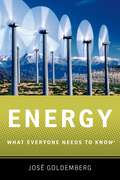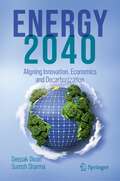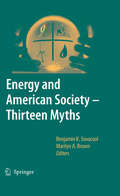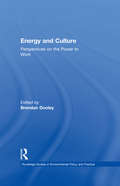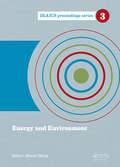- Table View
- List View
Energy: What Everyone Needs to Know® (What Everyone Needs To Know®)
by Jose GoldembergWithout a doubt, the topic of energy--from coal, oil, and nuclear to geothermal, solar and wind--is one of the most pressing across the globe. It is of paramount importance to policy makers, economists, environmentalists, and industry as they consider which technologies to invest in, how to promote use of renewable energy sources, and how to plan for dwindling reserves of non-renewable energy. In Energy: What Everyone Needs to Know®, José Goldemberg, a nuclear physicist who has been hailed by Time magazine as one of the world's top "leaders and visionaries on the environment," takes readers through the basics of the world energy system, its problems, and the technical as well as non-technical solutions to the most pressing energy problems. Addressing the issues in a Q-and-A format, Goldemberg answers such questions as: What are wind, wave, and geothermal energy? What are the problems of nuclear waste disposal? What is acid rain? What is the greenhouse gas effect? What is Carbon Capture and Storage? What are smart grids? What is the Kyoto Protocol? What is "cap and trade"? The book sheds light on the role of population growth in energy consumption, renewable energy resources, the amount of available energy reserves (and when they will run out), geopolitical issues, environmental problems, the frequency of environmental disasters, energy efficiency, new technologies, and solutions to changing consumption patterns. It will be the first place to look for information on the vital topic of energy. What Everyone Needs to Know® is a registered trademark of Oxford University Press.
Energy: What Everyone Needs to Know® (What Everyone Needs To Know®)
by Jose GoldembergWithout a doubt, the topic of energy--from coal, oil, and nuclear to geothermal, solar and wind--is one of the most pressing across the globe. It is of paramount importance to policy makers, economists, environmentalists, and industry as they consider which technologies to invest in, how to promote use of renewable energy sources, and how to plan for dwindling reserves of non-renewable energy. In Energy: What Everyone Needs to Know®, José Goldemberg, a nuclear physicist who has been hailed by Time magazine as one of the world's top "leaders and visionaries on the environment," takes readers through the basics of the world energy system, its problems, and the technical as well as non-technical solutions to the most pressing energy problems. Addressing the issues in a Q-and-A format, Goldemberg answers such questions as: What are wind, wave, and geothermal energy? What are the problems of nuclear waste disposal? What is acid rain? What is the greenhouse gas effect? What is Carbon Capture and Storage? What are smart grids? What is the Kyoto Protocol? What is "cap and trade"? The book sheds light on the role of population growth in energy consumption, renewable energy resources, the amount of available energy reserves (and when they will run out), geopolitical issues, environmental problems, the frequency of environmental disasters, energy efficiency, new technologies, and solutions to changing consumption patterns. It will be the first place to look for information on the vital topic of energy. What Everyone Needs to Know® is a registered trademark of Oxford University Press.
Energy: Perspectives, Problems, and Prospects
by Michael B. McElroyThe book offers a comprehensive account of how the world evolved to its present state in which humans now exercise a powerful, in many cases dominant, influence for global environmental change. It outlines the history that led to this position of dominance, in particular the role played by our increasing reliance on fossil sources of energy, on coal, oil and natural gas, and the problems that we are now forced to confront as a result of this history. The concentration of carbon dioxide in the atmosphere is greater now than at any time over at least the past 650,000 years with prospects to increase over the next few decades to levels not seen since dinosaurs roamed the Earth 65 million years ago. Comparable changes are evident also for methane and nitrous oxide and for a variety of other constituents of the atmosphere including species such as the ozone depleting chlorofluorocarbons for which there are no natural analogues. Increases in the concentrations of so-called greenhouse gases in the atmosphere are responsible for important changes in global and regional climate with consequences for the future of global society which, though difficult to predict in detail, are potentially catastrophic for a world poorly equipped to cope. Changes of climate in the past were repetitively responsible for the demise of important civilizations. These changes, however, were generally natural in origin in contrast to the changes now underway for which humans are directly responsible. The challenge is to transition to a new energy economy in which fossil fuels will play a much smaller role. We need as a matter of urgency to cut back on emissions of climate altering gases such as carbon dioxide while at the same time reducing our dependence on unreliable, potentially disruptive, though currently indispensable, sources of energy such as oil, the lifeblood of the global transportation system. The book concludes with a discussion of options for a more sustainable energy future, highlighting the potential for contributions from wind, sun, biomass, geothermal and nuclear, supplanting currently unsustainable reliance on coal, oil and natural gas.
Energy: Crises, Challenges and Solutions
by Pardeep SinghEnergy Global energy demand has more than doubled since 1970. The use of energy is strongly related to almost every conceivable aspect of development: wealth, health, nutrition, water, infrastructure, education and even life expectancy itself are strongly and significantly related to the consumption of energy per capita. Many development indicators are strongly related to per-capita energy consumption. Fossil fuel is the most conventional source of energy but also increases greenhouse gas emissions. The economic development of many countries has come at the cost of the environment. However, it should not be presumed that a reconciliation of the two is not possible.The nexus concept is the interconnection between the resource energy, water, food, land, and climate. Such interconnections enable us to address trade-offs and seek synergies among them. Energy, water, food, land, and climate are essential resources of our natural environment and support our quality of life. Competition between these resources is increasing globally and is exacerbated by climate change. Improving resilience and securing resource availability would require improving resource efficiency. Many policies and programs are announced nationally and internationally for replacing the conventional mode and also emphasizing on conservation of fossil fuels and reuse of exhausted energy, so a gap in implications and outcomes can be broadly traced by comparing the data.This book aims to highlight problems and solutions related to conventional energy utilization, formation, and multitudes of ecological impacts and tools for the conservation of fossil fuels. The book also discusses modern energy services as one of the sustainable development goals and how the pressure on resource energy disturbs the natural flows. The recent advances in alternative energy sources and their possible future growth are discussed and on how conventional energy leads to greenhouse gas formation, which reduces energy use efficiency. The different policies and models operating is also addressed, and the gaps that remained between them. Climate change poses a challenge for renewable energy, and thus it is essential to identify the factors that would reduce the possibility of relying on sustainable energy sources.This book will be of interest to researchers and stakeholders, students, industries, NGOs, and governmental agencies directly or indirectly associated with energy research.
Energy: Crises, Challenges and Solutions
by Pardeep Singh Suruchi Singh Gaurav Kumar Pooja BawejaEnergy Global energy demand has more than doubled since 1970. The use of energy is strongly related to almost every conceivable aspect of development: wealth, health, nutrition, water, infrastructure, education and even life expectancy itself are strongly and significantly related to the consumption of energy per capita. Many development indicators are strongly related to per-capita energy consumption. Fossil fuel is the most conventional source of energy but also increases greenhouse gas emissions. The economic development of many countries has come at the cost of the environment. However, it should not be presumed that a reconciliation of the two is not possible.The nexus concept is the interconnection between the resource energy, water, food, land, and climate. Such interconnections enable us to address trade-offs and seek synergies among them. Energy, water, food, land, and climate are essential resources of our natural environment and support our quality of life. Competition between these resources is increasing globally and is exacerbated by climate change. Improving resilience and securing resource availability would require improving resource efficiency. Many policies and programs are announced nationally and internationally for replacing the conventional mode and also emphasizing on conservation of fossil fuels and reuse of exhausted energy, so a gap in implications and outcomes can be broadly traced by comparing the data.This book aims to highlight problems and solutions related to conventional energy utilization, formation, and multitudes of ecological impacts and tools for the conservation of fossil fuels. The book also discusses modern energy services as one of the sustainable development goals and how the pressure on resource energy disturbs the natural flows. The recent advances in alternative energy sources and their possible future growth are discussed and on how conventional energy leads to greenhouse gas formation, which reduces energy use efficiency. The different policies and models operating is also addressed, and the gaps that remained between them. Climate change poses a challenge for renewable energy, and thus it is essential to identify the factors that would reduce the possibility of relying on sustainable energy sources.This book will be of interest to researchers and stakeholders, students, industries, NGOs, and governmental agencies directly or indirectly associated with energy research.
Energy: All That Matters (All That Matters)
by Professor Paul L YoungerEnergy is probably the defining topic of our age. Uncertainty over the long-term availability of some hydrocarbons and nuclear fuels are increasingly prompting volatility in energy prices on world markets. Meanwhile, no serious scientist doubts that the unabated atmospheric emissions of carbon dioxide associated with traditional forms of energy use are (at very least) exacerbating natural variations in climate in undesirable ways. For either reason or both, few commentators of any stature argue that "do nothing" is a credible option in the world of energy management. The technical challenges are legion; yet energy is just as much a socio-economic issue. Surprisingly, there are no authoritative books giving an overall introduction to energy for general readers, students, engineers, geographers or architects, offering adequate coverage of the scientific, engineering, environmental, social and economic dimensions in a single, reasonably-sized and easily-readable volume. The book proposed here seeks to fill that gap.All That Matters about energy. All That Matters books are a fast way to get right to the heart of key issues.
ENERGY 2040: Aligning Innovation, Economics and Decarbonization
by Deepak Divan Suresh SharmaAccess to energy is essential for our daily lives, economic growth, environment, and sustainability. However, our use of fossil fuels has contributed to global climate change, which poses a significant threat to society and life on this planet. Yet, it has been challenging to reconcile the perceived conflict between economics and climate change, which has created deep divisions in our society. ENERGY 2040: Aligning Innovation, Economics, and Decarbonization provides a holistic and comprehensive analysis of the ongoing energy transition and its underlying causes. It presents a viable path to meet the energy, economic, and climate goals by weaving together science, technology, economics, policy, entrepreneurship, and geopolitics. The book presents a captivating narrative that brings together a range of topics, including new and disruptive technologies with steep learning rates, the challenges of the future power grid, the democratization of energy, and reducing the timeline from science to impact at scale. It also explores the complex role of scientific research, disruptive deep tech, entrepreneurship, and policy in accelerating this energy transformation. This book is a must-read for anyone interested in understanding the future of energy. Whether you're a scientist, energy-industry practitioner, policymaker, investor, student, or concerned citizen, this book offers critical insights into the complex and evolving world of energy, innovation, decarbonization, and climate change.
An Energy Analysis of Household Consumption: Changing Patterns of Direct and Indirect Use in India (Alliance for Global Sustainability Bookseries #13)
by Shonali PachauriWith energy consumption set to become one of the biggest issues in the daily lives of householders around the world, this book could not be more relevant – despite the fact that it focuses on India. Pachauri adopts a socio-economic approach to analyzing the energy system and energy consumption in India from a household perspective. The work also incorporates two crucial aspects often ignored: namely, the importance of non-commercial sources of energy, and diversity in the patterns of energy usage.
Energy and American Society – Thirteen Myths
by Benjamin K. Sovacool Marilyn A. BrownThis book takes on a central quandary in the study of energy and environmental policy: What myths continue to exist in American culture concerning energy, the environment, and society? It enrolls twenty-four of the nation’s top experts working on energy policy to debunk and contextualize thirteen energy myths relating to electric power, renewable energy, energy efficiency, transportation, and climate change. The book will appeal to an international audience.
Energy and Charge Transfer in Organic Semiconductors
by Kohzoh MasudaGreat progress has been made in the field of ordinary semiconductor physics and associated technologies. For the time being, if we could use new materials such as organic semiconductors progress in electronics could be accelerated. Characteristics of organic semiconductors that are superior to others are: i) high photo-conductivity under irradiation along with low leakage current in the dark, ii) high sensitivity of the conductivity to various gases and to pressure. iii) possibility of using them in the amorphous state, iv) possibility of making devices of extremely small size, v) large variety of the materials, which makes suitable choice of material component easy. A possible future development is a highly conductive material which could be used for electric power transmission - and which might help solve some of the problems posed by transmission losses. The U.S.-Japan Seminar on Energy and Charge Transfer in Organic Semiconductors was held in Osaka Japan, 6-9 August, 1973. Completed results were summarized and the direction for the future was discussed. Information was exchanged quite freely and actively in a pleasant atmosphere. Many of the papers presented at the seminar are published here but unfortunately a few could not be included. It would give us great pleasure if this seminar could be one step in the further development of the research in this field.
Energy and Climate: Vision for the Future
by Michael B. McElroyThe climate of our planet is changing at a rate unprecedented in recent human history. The energy absorbed from the sun exceeds what is returned to space. The planet as a whole is gaining energy. The heat content of the ocean is increasing; the surface and atmosphere are warming; mid-latitude glaciers are melting; sea level is rising. The Arctic Ocean is losing its ice cover. None of these assertions are based on theory but on hard scientific fact. Given the science-heavy nature of climate change, debates and discussions have not played as big a role in the public sphere as they should, and instead are relegated to often misinformed political discussions and inaccessible scientific conferences. Michael B. McElroy, an eminent Harvard scholar of environmental studies, combines both his research chops and pedagogical expertise to present a book that will appeal to the lay reader but still be grounded in scientific fact. In Energy and Climate: Vision for the Future, McElroy provides a broad and comprehensive introduction to the issue of energy and climate change intended to be accessible for the general reader. The book includes chapters on energy basics, a discussion of the contemporary energy systems of the US and China, and two chapters that engage the debate regarding climate change. The perspective is global but with a specific focus on the US and China recognizing the critical role these countries must play in addressing the challenge of global climate change. The book concludes with a discussion of initiatives now underway to at least reduce the rate of increase of greenhouse gas emissions, together with a vision for a low carbon energy future that could in principle minimize the long-term impact of energy systems on global climate.
Energy and Climate: Vision for the Future
by Michael B. McElroyThe climate of our planet is changing at a rate unprecedented in recent human history. The energy absorbed from the sun exceeds what is returned to space. The planet as a whole is gaining energy. The heat content of the ocean is increasing; the surface and atmosphere are warming; mid-latitude glaciers are melting; sea level is rising. The Arctic Ocean is losing its ice cover. None of these assertions are based on theory but on hard scientific fact. Given the science-heavy nature of climate change, debates and discussions have not played as big a role in the public sphere as they should, and instead are relegated to often misinformed political discussions and inaccessible scientific conferences. Michael B. McElroy, an eminent Harvard scholar of environmental studies, combines both his research chops and pedagogical expertise to present a book that will appeal to the lay reader but still be grounded in scientific fact. In Energy and Climate: Vision for the Future, McElroy provides a broad and comprehensive introduction to the issue of energy and climate change intended to be accessible for the general reader. The book includes chapters on energy basics, a discussion of the contemporary energy systems of the US and China, and two chapters that engage the debate regarding climate change. The perspective is global but with a specific focus on the US and China recognizing the critical role these countries must play in addressing the challenge of global climate change. The book concludes with a discussion of initiatives now underway to at least reduce the rate of increase of greenhouse gas emissions, together with a vision for a low carbon energy future that could in principle minimize the long-term impact of energy systems on global climate.
Energy and Culture: Perspectives on the Power to Work (Routledge Studies in Environmental Policy and Practice)
by Brendan DooleyHow will humanity continue to meet its energy needs without destroying the conditions necessary to sustain human life on earth? The search for an answer to this question depends as much on the past as on the present; and as much on the physical sciences as on the social sciences. This book offers a truly trans-disciplinary and trans-cultural look at the problem of energy production and consumption in modern times. Discussing issues of history, politics, science, risk, lifestyle and representation, contributors demonstrate that experiences through time can provide insights into the kinds of solutions that have succeeded, as well as reasons why other solutions have failed. They also show what different countries and cultures might learn from each other, emphasizing how discoveries in one discipline have inspired new approaches in another discipline. Among many other important conclusions, the book suggests that energy transitions do not occur simply because of the exhaustion of old energy sources, and any solutions to the incipient energy crisis of the 21st century will depend on people's perceptions of science, environment and risk, informed and shaped in turn by the media.
Energy and Culture: Perspectives on the Power to Work (Routledge Studies in Environmental Policy and Practice)
by Brendan DooleyHow will humanity continue to meet its energy needs without destroying the conditions necessary to sustain human life on earth? The search for an answer to this question depends as much on the past as on the present; and as much on the physical sciences as on the social sciences. This book offers a truly trans-disciplinary and trans-cultural look at the problem of energy production and consumption in modern times. Discussing issues of history, politics, science, risk, lifestyle and representation, contributors demonstrate that experiences through time can provide insights into the kinds of solutions that have succeeded, as well as reasons why other solutions have failed. They also show what different countries and cultures might learn from each other, emphasizing how discoveries in one discipline have inspired new approaches in another discipline. Among many other important conclusions, the book suggests that energy transitions do not occur simply because of the exhaustion of old energy sources, and any solutions to the incipient energy crisis of the 21st century will depend on people's perceptions of science, environment and risk, informed and shaped in turn by the media.
Energy and Entropy: A Dynamic Duo
by Harvey S. LeffEnergy is typically regarded as understandable, despite its multiple forms of storage and transfer. Entropy, however, is an enigma, in part because of the common view that it represents disorder. That view is flawed and hides entropy’s connection with energy. In fact, macroscopic matter stores internal energy, and that matter’s entropy is determined by how the energy is stored. Energy and entropy are intimately linked. Energy and Entropy: A Dynamic Duo illuminates connections between energy and entropy for students, teachers, and researchers. Conceptual understanding is emphasised where possible through examples, analogies, figures, and key points. Features: Qualitative demonstration that entropy is linked to spatial and temporal energy spreading, with equilibrium corresponding to the most equitable distribution of energy, which corresponds to maximum entropy Analysis of energy and entropy of matter and photons, with examples ranging from rubber bands, cryogenic cooling, and incandescent lamps to Hawking radiation of black holes Unique coverage of numerical entropy, the 3rd law of thermodynamics, entropic force, dimensionless entropy, free energy, and fluctuations, from Maxwell's demon to Brownian ratchets, plus attempts to violate the second law of thermodynamics
Energy and Entropy: A Dynamic Duo
by Harvey S. LeffEnergy is typically regarded as understandable, despite its multiple forms of storage and transfer. Entropy, however, is an enigma, in part because of the common view that it represents disorder. That view is flawed and hides entropy’s connection with energy. In fact, macroscopic matter stores internal energy, and that matter’s entropy is determined by how the energy is stored. Energy and entropy are intimately linked. Energy and Entropy: A Dynamic Duo illuminates connections between energy and entropy for students, teachers, and researchers. Conceptual understanding is emphasised where possible through examples, analogies, figures, and key points. Features: Qualitative demonstration that entropy is linked to spatial and temporal energy spreading, with equilibrium corresponding to the most equitable distribution of energy, which corresponds to maximum entropy Analysis of energy and entropy of matter and photons, with examples ranging from rubber bands, cryogenic cooling, and incandescent lamps to Hawking radiation of black holes Unique coverage of numerical entropy, the 3rd law of thermodynamics, entropic force, dimensionless entropy, free energy, and fluctuations, from Maxwell's demon to Brownian ratchets, plus attempts to violate the second law of thermodynamics
Energy and Entropy: Equilibrium to Stationary States
by Michael E. StarzakThe study of thermodynamics is often limited to classical thermodynamics where minimal laws and concepts lead to a wealth of equations and applications. The resultant equations best describe systems at equilibrium with no temporal or s- tial parameters. The equations do, however, often provide accurate descriptions for systems close to equilibrium. . Statistical thermodynamics produces the same equilibrium information starting with the microscopic properties of the atoms or molecules in the system that correlates with the results from macroscopic classical thermodynamics. Because both these disciplines develop a wealth of information from a few starting postulates, e. g. , the laws of thermodyamics, they are often introduced as independent disciplines. However, the concepts and techniques dev- oped for these disciplines are extremely useful in many other disciplines. This book is intended to provide an introduction to these disciplines while revealing the connections between them. Chemical kinetics uses the statistics and probabilities developed for statistical thermodynamics to explain the evolution of a system to equilibrium. Irreversible thermodynamics, which is developed from the equations of classical thermodyn- ics, centers on distance-dependent forces, and time-dependent ?uxes. The force ?ux equations of irreversible thermodynamics lead are generated from the intensive and extensive variables of classical thermodynamics. These force ?ux equations lead, in turn, to transport equations such as Fick’s ?rst law of diffusion and the Nernst Planck equation for electrochemical transport. The book illustrates the concepts using some simple examples.
Energy and Environment
by Michel André Zissis SamarasTransport systems are facing an impossible dilemma: satisfy an increasing demand for mobility of people and goods, while decreasing their fossil-energy requirements and preserving the environment. Additionally, transport has an opportunity to evolve in a changing world, with new services, technologies but also new requirements (fast delivery, reliability, improved accessibility). In this book, recent research works are reported around the triptych: “transport, energy and environment”, which demonstrates that vehicle technologies and fuels can still improve, but it is necessary to prepare their implementation (e.g. electro-mobility), to think of new services, and to involve all actors, particularly enterprises, who will be the drivers of innovation. Mitigation strategies are studied to promote innovative, multimodal and clean transports and services. Research progress is reported on air pollution, vibrations and noise, their mitigation and assessment methodologies.
Energy and Environment
by Michel André Zissis SamarasTransport systems are facing an impossible dilemma: satisfy an increasing demand for mobility of people and goods, while decreasing their fossil-energy requirements and preserving the environment. Additionally, transport has an opportunity to evolve in a changing world, with new services, technologies but also new requirements (fast delivery, reliability, improved accessibility). In this book, recent research works are reported around the triptych: “transport, energy and environment”, which demonstrates that vehicle technologies and fuels can still improve, but it is necessary to prepare their implementation (e.g. electro-mobility), to think of new services, and to involve all actors, particularly enterprises, who will be the drivers of innovation. Mitigation strategies are studied to promote innovative, multimodal and clean transports and services. Research progress is reported on air pollution, vibrations and noise, their mitigation and assessment methodologies.
Energy and Environment
by Richard Loulou Jean-Philippe Waaub Georges ZaccourThis new work on energy and environmental modeling describes a broad variety of modeling methodologies, embodied in models of varying scopes and philosophies. Examples range from top-down integrated assessment models to bottom-up partial equilibrium models, to hybrid models.
Energy and Environment: Technological Challenges for the Future
by Y. H. Mori K. OhnishiIt is becoming evident that satisfying the ever-increasing global demand for energy is having a major impact on the environment. The technologies required to minimize such impacts are discussed here in an in-depth overview and review of a broad spectrum of energy and environmental issues. The first five sections of the book deal directly with scientific and technological topics: the production, transportation, and utilization of electric power; thermal science and engineering for energy conservation/utilization processes; gas hydrates; multiphase mechanics for energy and environmental technology; pollutants and radioactive wastes in the earth. The sixth section, unique in a book of this type, focuses on education, recording a panel discussion on solutions to problems of energy and environment. For specialists and nonspecialists alike, the book is thus a valuable guide to the technological challenges for the future.
Energy and Environment: Select Proceedings of ICWEES-2016 (Water Science and Technology Library #80)
by Vijay P Singh Shalini Yadav Ram Narayan YadavaThis book comprising seven parts is organized under two sections. The first section deals with environment containing four parts, whereas the second section, containing three parts, is on energy. The first part deals with some aspects of hydrologic impacts of global warming and anthropogenic changes. Part II is on bio-environment and discusses plants, biomass, and bacterial species. Part III focuses on chemical environment. Section one is concluded with Part IV on social environment. Section two starts out with Part V on solar energy. Hydropower is discussed in Part VI. The concluding Part VII deals with biogas. The book will be of interest to researchers and practitioners in the field of water resources, hydrology, environmental resources, agricultural engineering, watershed management, earth sciences, as well as those engaged in natural resources planning and management. Graduate students and those wishing to conduct further research in water and environment and their development and management may find the book to be of value.
Energy and Environment: Proceedings of the 2014 International Conference on Energy and Environment (ICEE 2014), June 26-27, Beijing, China
by Dawei ZhengThe 2014 International Conference on Energy and Environment (ICEE 2014) was held June 26-27 in Beijing, China. The objective of ICEE 2014 was to provide a platform for researchers, engineers, academics as well as industry professionals from all over the world to present their research results and development activities in Energy and Environment res
Energy and Environment in the Tropics (Lecture Notes in Energy #92)
by Shaharin Anwar SulaimanThe tropical zones are dominated by developing countries, which mainly face problematic environmental issues. Different than four-season countries, tropical countries have a continuous summer-like season and therefore they are rich in clean energy sources like solar and biomass. Hence, the mitigations of environment and energy issues in the tropics would require specific understanding and different approach to solutions. This book offers an assortment of studies on scenarios of environment as well as energy demand and power generation technologies in the tropics. Many of the countries within the tropics are highly populated, and this results in various problems related to the environment and energy. The demand for energy in these countries keeps increasing but concurrently there are also environmental issues that require serious attention. As the global concern on the environment is alarming today, the choice of power generation should be of the cleanest possible resource. This various reports on research activities carried out in the tropics on the aspect of environment and energy presented in this book are highly beneficial for those who like to see an improvement in the tropics with regard to environment and energy systems.
